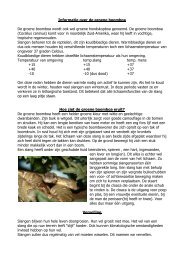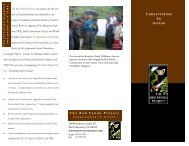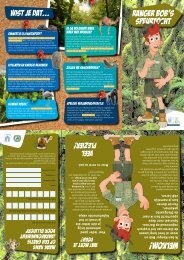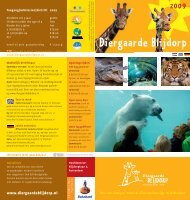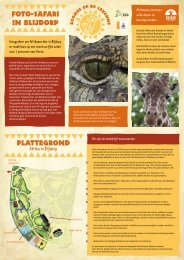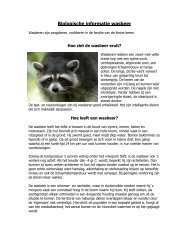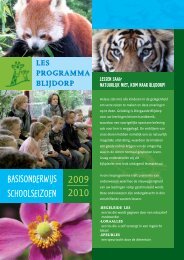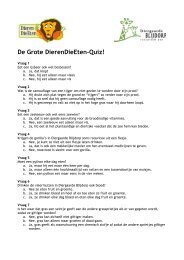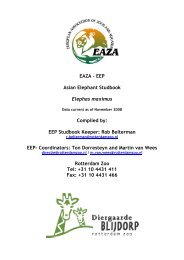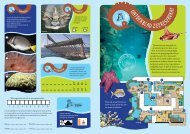European studbook for the giraffe eep
European studbook for the giraffe eep
European studbook for the giraffe eep
You also want an ePaper? Increase the reach of your titles
YUMPU automatically turns print PDFs into web optimized ePapers that Google loves.
Husbandry and management guidelines<br />
In 2006 husbandry and management guidelines were published. The guidelines are written by<br />
specialists, each in his or her own area of specialisation:<br />
Nutrition:<br />
Transport:<br />
Veterinary issues:<br />
Husbandry:<br />
General items:<br />
Marcus Clauss, University of Zürich, Schwitzerland.<br />
Jürgen Hummel, University of Bonn, Germany.<br />
Zdenek Barta, Dvur Králové, Czech Republic.<br />
Jacques Kaandorp, Hilvarenbeek, <strong>the</strong> Ne<strong>the</strong>rlands<br />
Ludek Culik, Dvur Králové, Czech Republic.<br />
Waltraut Zimmermann, Köln, Germany.<br />
Marc Damen, Arnhem, <strong>the</strong> Ne<strong>the</strong>rlands.<br />
Gün<strong>the</strong>r Schleussner, Stuttgart, Germany.<br />
Kristina Tomasova, Dvur Králové, Czech Republic.<br />
These guidelines were distributed to all participants in <strong>the</strong> Giraffe EEP in electronic <strong>for</strong>m and also<br />
published on <strong>the</strong> member area of <strong>the</strong> EAZA website. They were amended by <strong>the</strong> Giraffe EEP<br />
Species Committee and <strong>the</strong>re<strong>for</strong>e all participants in <strong>the</strong> Giraffe EEP are requested to follow <strong>the</strong>se<br />
guidelines in <strong>the</strong> husbandry and management of <strong>giraffe</strong>s.<br />
General actions <strong>for</strong> <strong>the</strong> year 2009 and later<br />
All pure <strong>giraffe</strong> females should be brought into a breeding situation as soon as possible; this<br />
means with a male of <strong>the</strong> same subspecies and without a male of ano<strong>the</strong>r subspecies.<br />
More important is to fur<strong>the</strong>r restrict <strong>the</strong> breeding of hybrid <strong>giraffe</strong>s. The EEP is now slowly<br />
coming in <strong>the</strong> position that <strong>the</strong> production of pure <strong>giraffe</strong>s can cope with <strong>the</strong> growth in spaces in<br />
<strong>the</strong> EEP; <strong>the</strong>se additional places should be taken by pure <strong>giraffe</strong>s only. The year 2009 will be<br />
mainly used to discuss with <strong>the</strong> new species committee if we can slowly put more restrictive<br />
measurements on <strong>the</strong> production of hybrids and to stop <strong>the</strong> production of hybrids. All of this needs<br />
to be done carefully to avoid empty <strong>giraffe</strong> enclosures.<br />
As already stated last year, we should avoid that hybrid males are in a breeding situation. In those<br />
exceptional cases where hybrid females are still breeding, <strong>the</strong>y should do so with pure males. That<br />
way pure males can be ‘tested’ <strong>for</strong> <strong>the</strong>ir reproductive capabilities and in case <strong>the</strong>re would be pure<br />
females available <strong>for</strong> this institution in <strong>the</strong> future, <strong>the</strong>y already have a pure male. All hybrid males<br />
should be placed in bachelor groups.<br />
In new, inexperienced, institutions <strong>the</strong> mortality of <strong>giraffe</strong>s turns out to be higher than in<br />
experienced institutions. This can be declared by <strong>the</strong> fact that <strong>the</strong> k<strong>eep</strong>ers and staff are less<br />
experienced with <strong>giraffe</strong>s and <strong>the</strong> facilities have not yet been tested by <strong>giraffe</strong>s. For that reason all<br />
new institutions have to start with a single sex group, ei<strong>the</strong>r males, or hybrid females, to gain<br />
experience. Once gained positive experience and if females become available at a certain point,<br />
one could switch to a breeding group. It would not be fair if new institutions start with a breeding<br />
group, while o<strong>the</strong>rs, who already gained experience and who followed <strong>the</strong> recommendations, have<br />
to stick to a bachelor group. Please be prepared to wait long be<strong>for</strong>e getting a breeding group of<br />
pure <strong>giraffe</strong>s; <strong>the</strong>re are already over 30 institutions waiting in line at <strong>the</strong> moment and please be<br />
aware we will always need single sex groups to control <strong>the</strong> development of <strong>the</strong> population.<br />
Still a few institutions are transporting <strong>giraffe</strong>s without approval of <strong>the</strong> Giraffe EEP to non-EEP<br />
participants. As one can see on <strong>the</strong> next page, <strong>the</strong>re are many alternative destinations within <strong>the</strong><br />
Giraffe EEP. As in previous years, all transfers that have not been approved by <strong>the</strong> Giraffe EEP<br />
will have to be reported to <strong>the</strong> Antelope and Giraffe TAG, in <strong>the</strong> interest of <strong>the</strong> Giraffe EEP and<br />
<strong>the</strong> institutions who are cooperating.<br />
15




